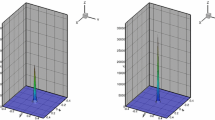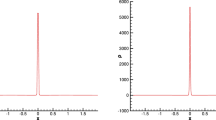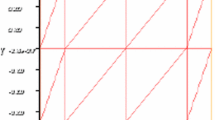Abstract
In this paper, we apply the local discontinuous Galerkin (LDG) method to solve the classical Keller–Segel (KS) chemotaxis model. The exact solution of the KS chemotaxis model may exhibit blow-up patterns with certain initial conditions, and is not easy to approximate numerically. Moreover, it has been proved that there exists a definition of free energy of the KS system which dissipates with respect to time. We will construct a consistent numerical energy and prove the energy dissipation with the LDG discretization. Several numerical experiments in one and two space dimensions will be given. Especially, for solutions with blow-up (converge to Dirac delta functions), the densities of KS model are computed to be strictly positive in the numerical experiments and the energies are also numerically observed to be strictly positive and decreasing as are seen in the figures. Therefore, the scheme is stable for the KS model with blow-up solutions.













Similar content being viewed by others
References
Bassi, F., Rebay, S.: A high-order accurate discontinuous finite element method for the numerical solution of the compressible Navier–Stokes equations. J. Comput. Phys. 131, 267–279 (1997)
Blanchet, A., Dolbeault, J., Perthame, B.: Two-dimensional Keller–Segel model: optimal critical mass and qualitative properties of the solutions. Electron. J. Differ. Equ. 44, 1–33 (2006)
Blanchet, A., Laurencot, P.: The Parabolic–Parabolic Keller-Segel System with Critical Diffusion as a Gradient Flow in \(R^d\), \(d\ge 3\). Commun. Partial Differ. Equ. 38, 658–686 (2013)
Blanchet, A., Carrillo, J., Kinderlehrer, D., Kowalczyk, M., Laurencot, P., Lisini, S.: A hybrid variational principle for the Keller–Segel system in \(R^2\). ESAIM:M2AN 49, 1553–1576 (2015)
Calvez, V., Corrias, L.: The parabolic–parabolic Keller–Segel model in \(R^2\). Commun. Math. Sci. 6, 417–447 (2008)
Chertock, A., Kurganov, A.: A second-order positivity preserving central-upwind scheme for chemotaxis and haptotaxis models. Numer. Math. 111, 169–205 (2008)
Childress, S., Percus, J.: Nonlinear aspects of chemotaxis. Math. Biosci. 56, 217–237 (1981)
Cockburn, B., Hou, S., Shu, C.-W.: The Runge–Kutta local projection discontinuous Galerkin finite element method for conservation laws IV: the multidimensional case. Math. Comput. 54, 545–581 (1990)
Cockburn, B., Lin, S.-Y., Shu, C.-W.: TVB Runge–Kutta local projection discontinuous Galerkin finite element method for conservation laws III: one-dimensional systems. J. Comput. Phys. 84, 90–113 (1989)
Cockburn, B., Shu, C.-W.: TVB Runge–Kutta local projection discontinuous Galerkin finite element method for conservation laws II: general framework. Math. Comput. 52, 411–435 (1989)
Cockburn, B., Shu, C.-W.: The Runge–Kutta discontinuous Galerkin method for conservation laws V: multidimensional systems. J. Comput. Phys. 141, 199–224 (1998)
Cockburn, B., Shu, C.-W.: The local discontinuous Galerkin method for time dependent convection–diffusion systems. SIAM J. Numer. Anal. 35, 2440–2463 (1998)
Cong, W., Liu, J.-G.: Uniform \(L^\infty \) boundedness for a degenerate parabolic–parabolic Keller–Segel model. Discrete Contin. Dyn. Syst. Ser. B 22, 307–338 (2017)
Epshteyn, Y.: Discontinuous Galerkin methods for the chemotaxis and haptotaxis models. J. Comput. Appl. Math. 224, 168–181 (2009)
Epshteyn, Y.: Upwind-difference potentials method for Patlak–Keller–Segel chemotaxis model. J. Sci. Comput. 53, 689–713 (2012)
Epshteyn, Y., Izmirlioglu, A.: Fully discrete analysis of a discontinuous finite element method for the Keller–Segel chemotaxis model. J. Sci. Comput. 40, 211–256 (2009)
Epshteyn, Y., Kurganov, A.: New interior penalty discontinuous Galerkin methods for the Keller–Segel chemotaxis model. SIAM J. Numer. Anal. 47, 368–408 (2008)
Fatkullin, I.: A study of blow-ups in the Keller–Segel model of chemotaxis. Nonlinearity 26, 81–94 (2013)
Filbet, F.: A finite volume scheme for the Patlak–Keller–Segel chemotaxis model. Numer. Math. 104, 457–488 (2006)
Gajewski, H., Zacharias, K.: Global behaviour of a reaction–diffusion system modelling chemotaxis. Math. Nachr. 195, 77–114 (1998)
Gottlieb, S., Shu, C.-W., Tadmor, E.: Strong stability-preserving high-order time discretization methods. SIAM Rev. 43, 89–112 (2001)
Guo, L., Yang, Y.: Positivity-preserving high-order local discontinuous Galerkin method for parabolic equations with blow-up solutions. J. Comput. Phys. 289, 181–195 (2015)
Hakovec, J., Schmeiser, C.: Stochastic particle approximation for measure valued solutions of the 2D Keller–Segel system. J. Stat. Phys. 135, 133–151 (2009)
Herrero, M.A., Medina, E., Velázquez, J.J.L.: Finite-time aggregation into a single point in a reaction–diffusion system. Nonlinearity 10, 1739–1754 (1997)
Herrero, M.A., Velazquez, J.J.L.: Singularity patterns in a chemotaxis model. Math. Annu. 306, 583–623 (1996)
Horstman, D.: From 1970 until now: the Keller–Segel model in chemotaxis and its consequences I. Jahresber. DMV 105, 103–165 (2003)
Horstmann, D.: From 1970 until now: the Keller–Segel model in chemotaxis and its consequences II. Jahresber. DMV 106, 51–69 (2004)
Ishida, S., Yokota, T.: Blow-up in finite or infinite time for quasilinear degenerate Keller–Segel systems of parabolic–parabolic type. Discrete Contin. Dyn. Syst. Ser. B 17, 2569–2596 (2013)
Keller, E.F., Segel, L.A.: Initiation on slime mold aggregation viewed as instability. J. Theor. Biol. 26, 399–415 (1970)
Li, X., Shu, C.-W., Yang, Y.: Local discontinuous Galerkin method for the Keller–Segel chemotaxis model. J. Sci. Comput. 73, 943–967 (2017)
Liu, J.-G., Wang, L., Zhou, Z.: Positivity-preserving and asymptotic preserving method for 2D Keller–Segel equations. Math. Comput. 87, 1165–1189 (2018)
Liu, J.-G., Wang, J.: Refined hyper-contractivity and uniqueness for the Keller–Segel equations. Appl. Math. Lett. 52, 212–219 (2016)
Marrocco, A.: 2D simulation of chemotaxis bacteria aggregation. ESAIM Math. Model. Numer. Anal. 37, 617–630 (2003)
Nagai, T.: Blow-up of radially symmetric solutions to a chemotaxis system. Adv. Math. Sci. Appl. 3, 581–601 (1995)
Nakaguchi, E., Yagi, Y.: Fully discrete approximation by Galerkin Runge–Kutta methods for quasilinear parabolic systems. Hokkaido Math. J. 31, 385–429 (2002)
Patlak, C.: Random walk with persistence and external bias. Bull. Math. Biophys. 15, 311–338 (1953)
Reed, W.H., Hill, T.R.: Triangular mesh methods for the neutron transport equation. Los Alamos Scientific Laboratory Report LA-UR-73-479, Los Alamos, NM (1973)
Saito, N.: Conservative upwind finite-element method for a simplified Keller–Segel system modelling chemotaxis. IMA J. Numer. Anal. 27, 332–365 (2007)
Saito, N.: Error analysis of a conservative finite-element approximation for the Keller–Segel system of chemotaxis. Commun. Pure Appl. Anal. 11, 339–364 (2012)
Strehl, R., Sokolov, A., Kuzmin, D., Horstmann, D., Turek, S.: A positivity-preserving finite element method for chemotaxis problems in 3D. J. Comput. Appl. Math. 239, 290–303 (2013)
Tyson, R., Stern, L.J., LeVeque, R.J.: Fractional step methods applied to a chemotaxis model. J. Math. Biol. 41, 455–475 (2000)
Yang, Y., Shu, C.-W.: Discontinuous Galerkin method for hyperbolic equations involving \(\delta \)-singularities: negative-order norm error estimates and applications. Numer. Math. 124, 753–781 (2013)
Yang, Y., Wei, D., Shu, C.-W.: Discontinuous Galerkin method for Krause’s consensus models and pressureless Euler equations. J. Comput. Phys. 252, 109–127 (2013)
Zhang, Y., Zhang, X., Shu, C.-W.: Maximum-principle-satisfying second order discontinuous Galerkin schemes for convection–diffusion equations on triangular meshes. J. Comput. Phys. 234, 295–316 (2013)
Zhao, X., Yang, Y., Syler, C.: A positivity-preserving semi-implicit discontinuous Galerkin scheme for solving extended magnetohydrodynamics equations. J. Comput. Phys. 278, 400–415 (2014)
Author information
Authors and Affiliations
Corresponding author
Additional information
The research of Li Guo was supported by the National Natural Science Foundation of China under the Grant 11601536. The research of Xingjie Helen Li was supported by the Simons Foundation Collaboration Grant: Award ID: 426935. The research of Yang Yang was supported by the NSF Grant DMS-1818467.
Rights and permissions
About this article
Cite this article
Guo, L., Li, X.H. & Yang, Y. Energy Dissipative Local Discontinuous Galerkin Methods for Keller–Segel Chemotaxis Model. J Sci Comput 78, 1387–1404 (2019). https://doi.org/10.1007/s10915-018-0813-8
Received:
Revised:
Accepted:
Published:
Issue Date:
DOI: https://doi.org/10.1007/s10915-018-0813-8




